Artificial Intelligence
Sovereign AI Platform for Public Services Delivery
This point of view talks about how public services delivery transformation can be achieved with a Sovereign AI platform leveraging Artificial Intelligence.
Insights
- Discuss on the need for AI enabled transformation in public services delivery
- Explore what various countries are doing in this space and the need to create a sovereign AI platform
- Key functional components required to create a Sovereign AI platform and its elaboration
Introduction
The Need for AI enabled Transformation
The integration of Artificial Intelligence (AI) into public services presents a transformative opportunity to enhance economic growth, optimize public service delivery and meet increasing expectations of citizens. AI has the potential to increase global GDP by 7% annually, as predicted by various studies. The International Data Corporation (IDC) forecasts a compound annual growth rate (CAGR) of 33.7% in the AI sector between 2022 and 2027, highlighting the rapid pace of AI adoption globally. As AI technologies continue to evolve, their application across public sectors is no longer optional but an imperative. The demand for smarter, faster, and more personalized public services is escalating, driven by global trends in AI-augmented service delivery across various sectors. Governments must seize this moment to identify new opportunities, generate revenue, and ensure their public services align with the evolving needs of their citizens.
What countries are doing in this area?
Globally, numerous countries have recognized the transformative power of AI in public services. By 2024, around 75 countries had released their AI strategies, showcasing a commitment to integrating AI into government functions. For instance, South Korea plans to invest $6.94 billion in AI by 2027, while Singapore has allocated $1 billion for AI development in its 2024 budget, focusing on building the next Smart Nation. Singapore's National AI Strategy 2.0 (NAIS 2.0) outlines a comprehensive plan for AI-driven services, creating a centralized resource hub for development of digital government products and services. In the United States, the federal government has budgeted $3 billion for AI initiatives in FY25, with over 700 AI use cases already implemented across various departments and agencies. These investments underscore the global momentum toward leveraging AI to enhance public service delivery and the need for governments worldwide to keep pace with these advancements.
The need to create AI enabled services
As AI adoption accelerates, governments are positioned to become the largest spenders in this domain, as observed by Gartner. National AI strategies have acknowledged the necessity of high-end computing and GPU infrastructure to scale AI services. However, the ecosystem required to deliver these services is still maturing. Current AI use cases in government are often limited to pilot implementations or proof-of-concept projects, with a few live applications in sectors like agriculture and public safety. These initiatives tend to be fragmented, driven by the specific needs of individual departments. To realize the full potential of AI in public services, there is a pressing need to define a cohesive methodology and establish an AI ecosystem that brings together all stakeholders. This ecosystem should focus on key areas such as data management, service delivery, AI models, and regulatory support. The goal is to drive widespread AI adoption, enhance precision in public service delivery, increase transparency, and foster partnerships that will sustain and evolve the platform.
Evolution of Public Services Delivery from Governments
The delivery of public services by governments has undergone a significant transformation over the years, evolving through five distinct stages.
PRE-ERA OF DIGITIZATION During this period, public services were primarily paper-driven, manually managed, and highly dependent on individual personnel. Operations were siloed, with minimal inter-departmental collaboration, resulting in non-standardized processes, legacy systems, and compromised data security. The absence of regulatory support further hindered the efficiency of service delivery.
DAWN OF DIGITIZATION The advent of digital technology marked the beginning of innovation in public services. Governments started creating digital portals, introducing electronic forms, and offering multi-channel support through web, email, and phone. This era saw the introduction of IT infrastructure, process standardization, and initial collaborations between departments, laying the groundwork for more efficient service delivery. Basic regulatory mechanisms also began to take shape during this period.
E-GOVERNANCE The next phase of evolution involved the total digitization of government services. Workflow identification, inter-departmental integrations, and data sharing became commonplace. Mobility services were introduced, enabling citizens to access services on the go. Cloud-enabled services further enhanced the efficiency and scalability of public service delivery. Comprehensive IT policies and strategies were developed, and governments began adopting emerging technologies, significantly improving service delivery.
E-GOVERNANCE WITH WORKFLOW INTEGRATION, AUTOMATION, ANALYTICS & INITIAL AI ADOPTION This stage marked the beginning of end-to-end digital service delivery, with complete workflow integration and automated decision-making powered by AI. Governments strengthened their IT infrastructure, introduced analytics and KPI tracking, and began offering personalized services. The initial adoption of AI enabled governments to deliver more efficient and targeted services, while data security and privacy protection became top priorities. Regulatory frameworks and compliance measures were also strengthened during this period.
AI JOURNEY ADOPTION In the most recent stage, governments have embraced AI-driven services, enabling automated and personalized citizen interactions. Value-added services are increasingly being delivered through private partnerships, supported by AI-driven forecasts and predictions. Continuous improvements based on AI insights have become the norm, and governments are investing in high-end computing infrastructure to support these advancements. This stage represents the pinnacle of public service delivery, where AI plays a central role in enhancing efficiency, transparency, and citizen satisfaction.
Figure 1: An insight into evolution of Public Services Delivery by Governments
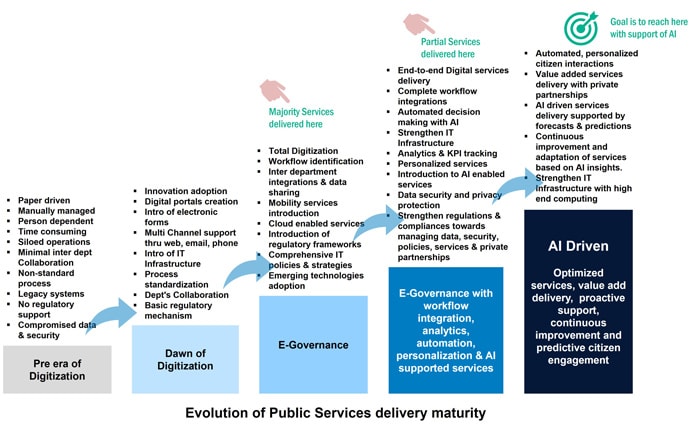
Technology adoption in the Evolution Journey
The evolution of public service delivery has been closely tied to the adoption of technology at each stage:
- PRE-ERA OF DIGITIZATION Governments primarily focused on managing data, with little to no digital infrastructure in place.
- DAWN OF DIGITIZATION The introduction of digital portals enabled better data management and access, laying the foundation for more efficient service delivery.
- E-GOVERNANCE With the adoption of cloud computing, governments began offering services through mobile applications and utilizing analytics to improve service delivery.
- E-GOVERNANCE WITH WORKFLOW INTEGRATION, AUTOMATION, ANALYTICS & INITIAL AI ADOPTION At this stage, governments adopted containerization, API-based services, real-time analytics, and began integrating AI into their workflows.
- AI JOURNEY ADOPTION The current stage involves the use of intelligent, actionable dashboards, sector-specific AI models, and the servitization of public services. Governments are increasingly partnering with startups and private organizations to deliver value-added services, leveraging advanced AI technologies.
Figure 2: Technology adoption for Services Delivery by Governments
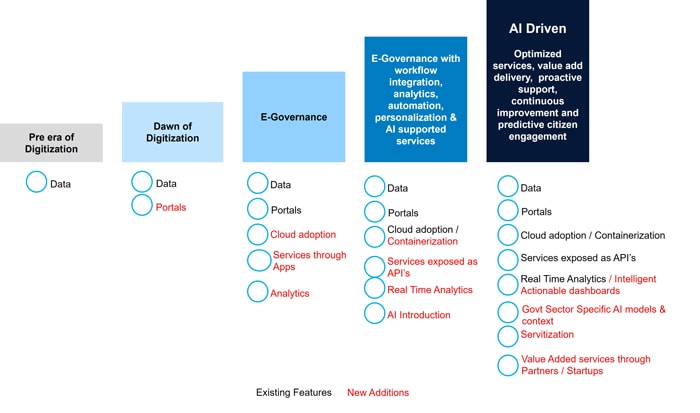
Why the need to set up a Sovereign AI Platform?
The evolution of public service delivery and technology adoption underscores the need for a Sovereign AI Platform. National AI strategies have highlighted the importance of high-end computing and GPU infrastructure to scale AI services. However, the ecosystem required to offer these services is still in its infancy. Most AI use cases in government are limited to pilots or proof-of-concept implementations, with only a few live applications in sectors like agriculture and public safety. These initiatives are often driven by fragmented AI projects within individual departments, lacking a cohesive approach.
To address this, there is a need to define a comprehensive methodology for building an AI ecosystem that encompasses data management, service delivery, AI models, and regulatory support. This initiative can be likened to defining an enterprise architecture strategy in an IT organization, where modernization and transformation initiatives are systematically adopted. A Sovereign AI Platform ecosystem for government IT systems would similarly focus on rationalizing portfolios and driving AI-based transformation.
Figure 3: Solution Rationale

Key areas of focus for setting up an AI platform are
- Data As the primary driver of government service delivery, data is foundational for AI adoption. However, this data is often dispersed across multiple entities, necessitating complex integrations to provide the right information for public services.
- Services The availability of services for public consumption through APIs is critical.
- AI Models Contextual AI models are needed to infuse intelligence into services by leveraging relevant data from various government departments.
- Governance A governance body is essential to control ownership and establish regulations across data, services, and AI models.
Key Architecture building blocks to build a Sovereign AI Platform
DataXChange Data is the cornerstone of government service delivery and plays a crucial role in AI adoption. However, this data is often scattered across various government bodies, creating challenges in integration and access. DataXChange can break silos in data availability, reducing the time needed to locate relevant data. It can also maintain internal and confidential government-centric data to manage operations, report efficiently, and track departmental KPIs.
Figure 4: An Illustration of DataXchange Platform
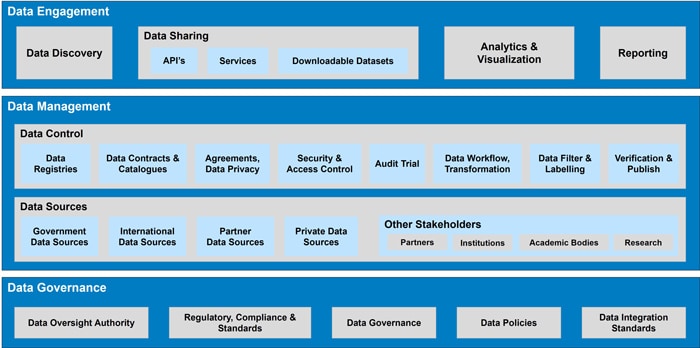
Key functions of DataXChange are:
| Data Engagement | This includes data discovery, sharing data through APIs, services, downloadable datasets, analytics, visualizations, and reporting. |
|---|---|
| Data Management - Data Control | This area involves the management of various aspects of data, including data registries, contracts, and catalogs. It also covers critical functions like ensuring data privacy, enforcing security measures, implementing access controls, maintaining audit trails, managing data workflows, and handling data transformations. Additional considerations include data filtering, labeling, verification, and publishing processes, which ensure that the data used in AI applications is accurate, relevant, and secure. |
| Data Management - Data Sources | Data is derived from various sources, including government databases, international data repositories, partner organizations, and private entities. This section emphasizes the importance of integrating data from diverse stakeholders such as academic institutions, research organizations, and industry partners. The goal is to create a comprehensive and cohesive data ecosystem that supports AI-driven public services. |
| Data Governance | Data Oversight Authority A central regulatory body is essential to oversee data governance, ensuring compliance with relevant standards and regulations. This authority would be responsible for establishing and enforcing data policies, maintaining data integration standards, and ensuring that data used across the ecosystem is secure, accurate, and accessible. The oversight authority would also address issues related to data ownership, privacy, and security, providing a framework for ethical data usage in government services. |
ServiceXChange: Services should be exposed as APIs for internal and public usage, promoting participation from private organizations and startups. This would allow for value-added services and the utilization of marketplace solutions for service delivery.
ServiceXChange is the core of the AI-driven public services ecosystem, enabling seamless access to services through various channels.
Figure 5: An Illustration of ServiceXchange Platform
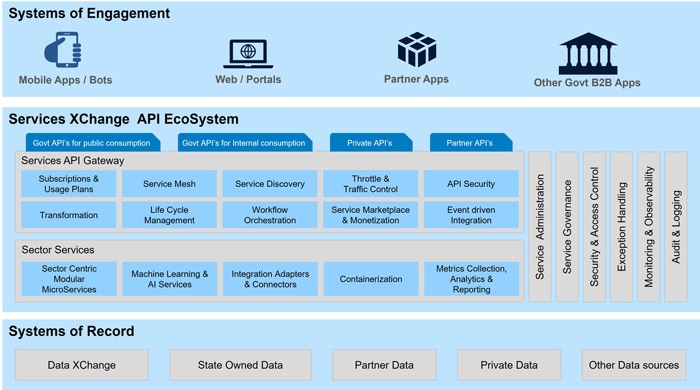
Key functions of ServiceXChange are:
| Systems of Engagement | This component focuses on the different channels through which citizens and internal users can access government services. These include web applications, portals, mobile apps, chatbots, partner applications, and interfaces for intergovernmental departments and bodies. The goal is to ensure that services are easily accessible, user-friendly, and available across multiple platforms. |
|---|---|
| ServiceXChange API Ecosystem - Services API Gateway. | This area covers critical functions like service mesh, service discovery, throttle control, traffic management, load balancing, API security, and transformation needs. It also includes workflow orchestration, API subscriptions, usage plans, and lifecycle management. The gateway facilitates the management of service marketplaces, monetization strategies, and event-driven integrations, ensuring that APIs are efficiently managed and accessible. |
| ServiceXChange API Ecosystem - Sector Services | This component addresses the management of modular services, machine learning, AI services, service integration adapters, and connectors. It also covers containerization, metrics collection for analytics, and reporting. APIs within this ecosystem are available for public consumption, internal use, and by partners and private entities. Additionally, common services provided in the ecosystem include service administration, governance, audit management, log management, and exception handling, ensuring a robust and secure service delivery framework. |
| Systems of Records | This involves leveraging the data available through DataXChange, including state-owned datasets, partner datasets, private datasets, and other datasets from institutions, academic bodies, and research organizations. The focus is on ensuring that the data underpinning the services is reliable, comprehensive, and well-managed, supporting the delivery of accurate and efficient AI-driven services. |
AIXChange: This would be a collection of AI models (typically GPTs addressing specific domain needs) available for consumption by various government services. The purpose of these models and platforms is to extend AI-enabled support for government services delivery. AIXChange is the AI model repository and management system that powers AI-driven public services.
Figure 6: An Illustration of AIXchange Platform
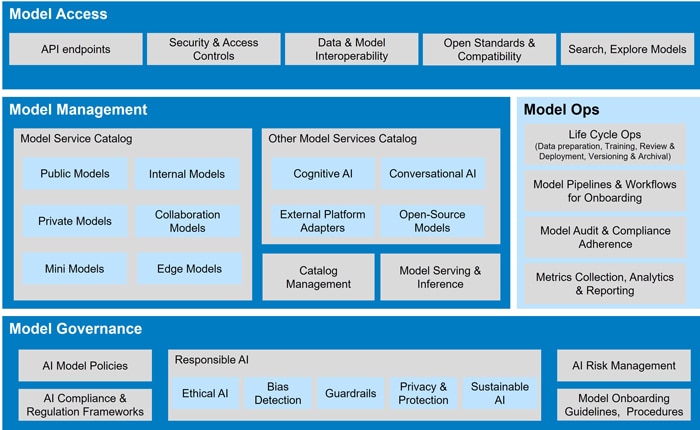
Key functions of AIXChange are:
| Model Access | This involves exposing AI models as API endpoints, managing security and access controls, ensuring interoperability between data and models, and adhering to open standards like ONNX and PMML. The goal is to ensure that AI models can be easily integrated and utilized across various government services, providing flexibility and scalability in AI adoption. |
|---|---|
| Model Management – Catalogs | This includes managing a comprehensive catalog of AI models, such as public models, internally accessed models, privately hosted models, partner collaboration models, mini models, and edge models. The catalog also encompasses cognitive AI models, conversational AI models, open-source models, and external platform integration adapters. Effective catalog management ensures that the right AI models are available for the right applications, promoting efficient service delivery. |
| Model Serving and Inferencing | This involves deploying models in production environments, ensuring they are efficiently serving and inferring data to provide accurate and timely insights for public services. |
| Model Ops | This covers the lifecycle operations of AI models, including data preparation, training, review, deployment, and management. It also involves auditing models, ensuring compliance with relevant regulations, collecting metrics on model usage, and reporting on performance. Model Ops is critical for maintaining the accuracy, reliability, and ethical use of AI models throughout their lifecycle. |
| Model Pipeline | This workflow manages the onboarding of models, from initial development through deployment and ongoing maintenance. It includes model audit procedures, compliance adherence, and version control, ensuring that models remain effective and up to date. |
| Model Governance | This involves establishing policies and frameworks for AI model governance, including risk management, compliance with regulatory frameworks, and adherence to guidelines for responsible AI use. It emphasizes the importance of ethical AI practices, including bias detection, enforcement of guardrails, privacy protection, and sustainability in AI operations. |
Drawing a parallel, an AIXChange model collection will be like Model Zoo offered by MONAI which hosts a collection of medical imaging models.
Governance Authority: Establishing a regulatory and ownership body to manage security, policies, access control, and the handling of PII data, workflow, publishing mechanisms, retention, and archival processes related to data, services, and AI models built for specific purposes is critical. This body would oversee all central functions. The regulatory and governance body plays a crucial role in overseeing the entire AI ecosystem, ensuring that all components - data, services, and AI models are managed effectively.
Key responsibilities of Governance Authority are:
| Governance | Establishing clear ownership and control over data, services, and AI models. It sets the policies and frameworks necessary to ensure the security, privacy, and ethical use of data and AI technologies. |
|---|---|
| Regulatory Compliance | Ensuring that all AI activities comply with national and international regulations. This includes managing PII data, enforcing security protocols, and adhering to data governance standards. |
| Policy Frameworks | Developing and implementing policies related to data security, AI model usage, and service delivery. This framework is essential for maintaining public trust and ensuring that AI-driven services are transparent, accountable, and aligned with public interest. |
Figure 7: Sovereign AI Platform with support of Regulatory framework
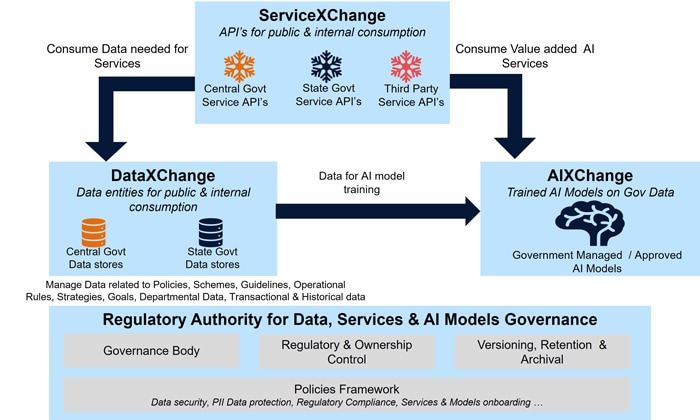
A brief list of use case for delivering AI enabled services through Sovereign AI Platform are listed below. These services could be Personalized services delivered to citizens requesting such services or in public services where services are augmented leveraging AI.
Figure 8: Example use cases for Personalized services / enhanced Public Services with AI
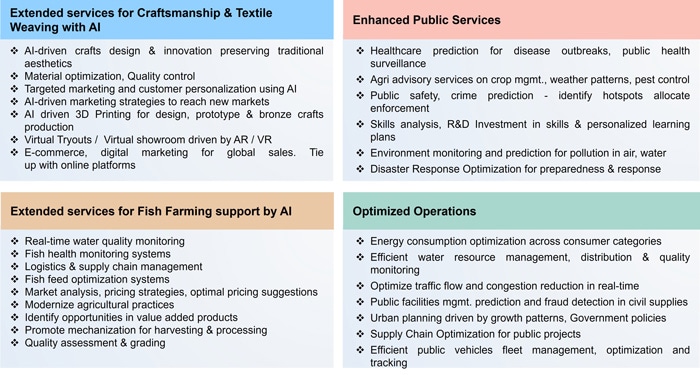
Conclusion
The implementation of a Sovereign AI Platform represents a significant advancement in the digital transformation of government services. This platform integrates with existing IT ecosystems, which include IT infrastructure, applications, and support from various innovation and research centers. The involvement of startups, focused centers of excellence, consortiums, and collaborations with private organizations, government bodies, industries, academic institutions, innovation networks, and mentorship programs further strengthens the platform's capabilities.
Figure 9: How does components of Sovereign AI Platform fit into IT / AI Ecosystem ?
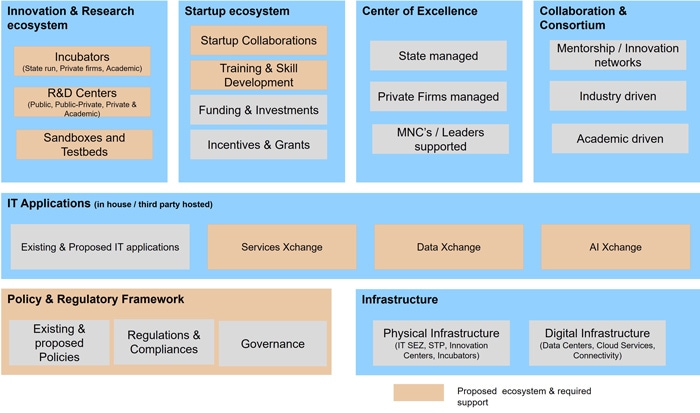
Benefits of adopting Sovereign AI ecosystem by governments provides:
- Speed of Execution and Service Delivery Accelerating the pace of service delivery to meet citizen expectations.
- Trust and Reach Building trust among people and investors, while expanding the reach of public services.
- Cost Reduction and Optimization Reducing operational costs and optimizing resource utilization.
- Transformational Public Services Delivery Facilitating the transition to AI-driven, agile, and precision-driven public services.
- Threat Detection and Risk Management Enhancing early detection of threats and risks, ensuring public safety.
- Innovation and Transparency Fostering innovation through public-private partnerships and enhancing transparency in service delivery.
- Data Ownership and Regulation Ensuring that data ownership and regulation drive AI-based transformation, promoting ethical and responsible AI use.
Sovereign AI Platform not only modernizes public service delivery but also sets the stage for a future where technology-driven transformation and transparency are at the core of government operations.
With success of Open Network Digital Platform (ONDC) for adoption of digital commerce, there is a need to establish a public platform for AI services like Sovereign AI platform where government can build and offer AI enabled services and models which can be adopted by Government agencies to extend AI centric services to public.
References
Throughout this point of view preparation, information and insights were drawn from a range of reputable sources, including research papers, articles, and resources. Some of the key references that informed the content of this point of view include:
- Impact of AI on economic Development
- Implications of AI on economic growth
- AI will transform Global economy
- Singapore National AI strategy (NAIS 2.0) outlines their journey towards next Smart Nation
- Singapore provides a one-stop resource hub for government digital products
- Federal Government wide array of more than 700+ public use cases
- Gartner observes that "Governments are poised to be the biggest AI spenders by industry".
- Stanford university AI Index report 2024
- International Data Corporation predicted 33.7% CAGR in AI
- India AI Report 2023
- Cluster Analysis of National AI Strategies
- Global AI Index details
- Open Network for Digital Commerce
- Medical Open Network for Artificial Intelligence
- Scaling Transformation of Government Services
These references provided the foundation upon which the discussions, insights, and recommendations in this point of view were based.

Subscribe
To keep yourself updated on the latest technology and industry trends subscribe to the Infosys Knowledge Institute's publications
Count me in!









